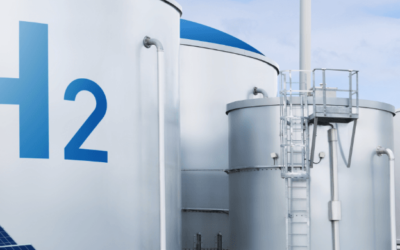The results of this year’s Innovation Fund call are in. EGEN is very pleased, together with the other PNO Group brands, to have contributed to so many successful applications. A crucial part of the Innovation Fund application is the GHG calculation. Not only is this an important evaluation criterium on its own, but it also affects other evaluation criteria, such as the cost efficiency and scalability of the project.
GHG calculations have gained significance in the evaluation process
In recent years, we have seen a growing emphasis on accurate and reliable calculations of greenhouse gas (GHG) emissions. These calculations have gained significance as they now carry more weight in the evaluation process. Moreover, the guidelines for GHG methodology and the corresponding calculator have evolved and become increasingly intricate over the years.
At EGEN’s Impact Assessment Centre, we have a team of skilled specialists with a profound understanding of GHG calculations, in particular in context of the Innovation Fund. We take immense pride in our track record of achieving the maximum possible score for the GHG calculation in every Innovation Fund application we’ve been involved in this year.
The GHG emission criterion’s score is determined by considering absolute GHG avoidance, relative GHG avoidance, and the overall quality of the calculation. In addition, some bonus points can be obtained, which can increase the score even more.
Below, we share with you our top five tips for achieving a high quality GHG calculation:
1. Early and proper scoping
It is crucial for the GHG calculation – and the Innovation Fund application as a whole – to clearly define the project. What falls within and outside of the project boundaries? What is the ultimate function of the principal product (i.e., main product)? The answers to these questions are essential for selecting the right sector to apply for and for following the appropriate steps in the GHG methodology. The scope, main product, and sector selection also play a role when defining the reference scenario, which leads us to point two.
2. Selecting the correct reference
The GHG calculation for the Innovation Fund application is an incremental analysis, meaning that the GHG emission avoidance potential is calculated by comparing the project to a reference scenario. When the principal product and the sector have been determined in the scoping phase, it is important to select the correct reference, as prescribed in the methodology. Using an incorrect reference situation can lead to a manifest error, which you want to avoid at all times.
3. Prevent a manifest error
A manifest error means that there are significant errors in your GHG calculation, resulting in an application that is no longer valid for evaluation. If such an error occurs, the evaluation of the Innovation Fund application comes to an immediate halt. In other words: if you make a manifest error, you’re out. Our tip to prevent this is to comply, comply and comply. Follow the methodology at every step and substantiate the choices you make using the GHG methodology.
4. Data validity and credible assumptions
A GHG calculation stands or falls with a proper substantiation of the choices and underlying assumptions. You must of course substantiate based on the GHG methodology, but you must also rely on your own process-specific information or external sources for the calculation. It’s crucial to keep a record of your assumptions and sources while ensuring your reasoning is logical and persuasive. By doing so, you ensure the validity and reliability of the calculation, leaving no room for doubt in achieving the estimated GHG emission avoidance.
5. Pay close attention to the bonus points
As mentioned earlier, extra points can be scored for the GHG calculation by means of bonus points. In total, three additional bonus points can be earned, for the following topics:
- Net carbon removals: Projects with a relative GHG emission avoidance of over 100% may be delivering net carbon removals. To be considered a net carbon removals project, and get this bonus point, a project must have negative emissions in the project scenario. Note however, that this must exclude GHG credits for non-principle products (by-products) and for timed operation of electricity consumption.
- Other GHG savings: If your project achieves emission avoidance outside the boundaries of the GHG methodology’s scope and the generic calculation – such as emissions associated with transport in energy intensive industries projects – this avoidance can yield a bonus point. When there are substantial GHG emissions savings from emission sources excluded from the project boundaries, the applicant should provide a separate calculation of potential emission savings, which may be considered under “Other GHG savings”.
- Commitment to use electricity from additional renewable energy sources: If your project uses green electricity from an additional renewable energy source, you can also earn an extra point for this. Examples are electricity supplied by a direct connection to a dedicated renewable source or wind electricity delivered by the grid, that would otherwise be curtailed.
Keep in mind that the Innovation Fund call contains some updates and changes each year. This also applies to the GHG calculation criterion. The tips provided are generic and based on our experience with the past Innovation Fund calls.
After proper GHG calculation comes monitoring and reporting
For successful projects it is important that the calculated GHG emission avoidance is actually achieved, in order to be entitled to the full funding. For this reason, strict monitoring and reporting of GHG avoidance follows after successful application. Did you know that we also offer support in GHG compliance after a successful application?
EGEN can help you prepare a compliant GHG calculation
At EGEN, we understand the challenges of conducting a precise GHG calculation for the Innovation Fund. We have experience with the complexities involved and are well-equipped to provide the expertise you need. If you are planning to submit an Innovation Fund application and require professional support for your GHG calculation, we are here to assist you every step of the way. Additionally, if you are interested in a GHG calculation for your project or product independently of the Innovation Fund call, our services are tailored to meet your specific needs. Please do not hesitate to contact us to explore how our specialized assistance can contribute to your success. We are committed to helping you make a positive environmental impact while achieving your objectives.


